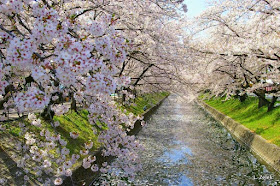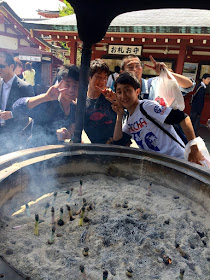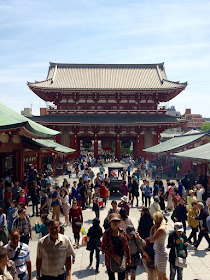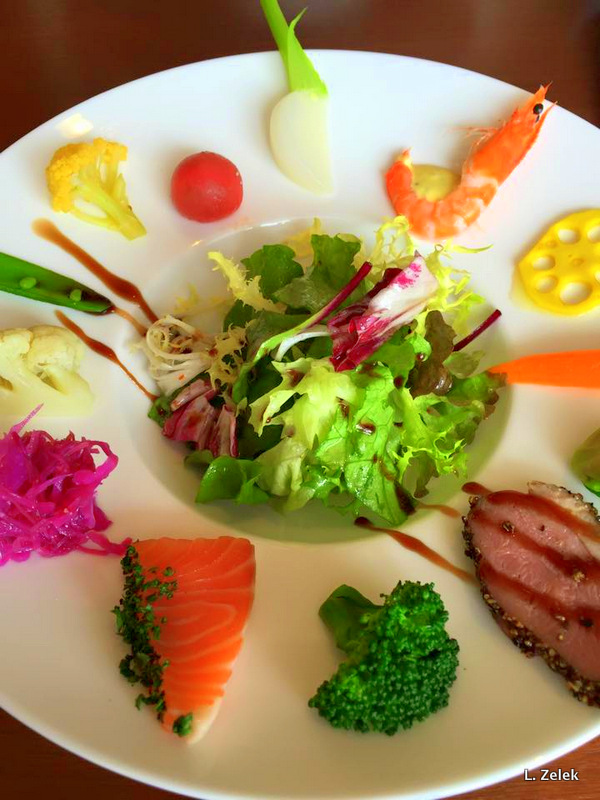And a soft, blush-pink canopy drapes the skies of Tokyo, like someone swept a paintbrush over the city to give its people one collective excuse to let go of daily cares and live in the moment under colorful splendor.

Sakura trees in Hamamatsu, Japan - March, 2016
Chefs at closet-sized sidewalk stands shout “Irasshaimase (いらっしゃいませ)!” to customers as they grill chicken (yakitori), beef, and leeks wrapped in slices of bacon on sticks.

Teenage students in front of a large cauldron of incense at Senso-ji temple. People waft the fumes over their bodies to bestow good health – April, 2015
Kites shaped like colorful carp and smiling, eye-less daruma dolls are placed in store windows.
Religious and cultural matsuris (festivals) transform temples, shrines and quiet parks into buzzing centers of activity, as they nestle between skyscrapers. Japanese boys say “Hai, pisu!” to me.

Crowds roam the grounds of Senso-ji temple in Asakusa, Tokyo - April 2015
I just love the arrival of spring in Japan, the time of year where “sakura,” (桜) or cherry blossoms, spring into bloom across virtually every stretch of Japan’s 47 prefectures, drawing hundreds of revelers for viewing, parties, and resolution-setting.
For hundreds of years, the sakura culture has been rooted in the “cycle of life, death and rebirth, on the one hand, and of productive and reproductive powers on the other.” It’s a bittersweet phenomenon, as people gather to celebrate the blossoming beauty while sadly anticipating their ending.

Jumping school girls: My friend Allyson and I celebrating sakura at the International School of Sacred Heart -April 2005
I have lovely, impactful memories of visiting various cherry blossom locations, participating in hanami (花見) or “flower viewing” with my parents and friends, and eating special treats, since in Japan the seasons aren’t just something to see – they’re something to taste, too.
Sakura mochi at my host family’s residence in Hamamatsu, Japan - March 2016
Just another big reason for making spring the time to visit this nothing-less-than-magical country.
Where to go:
Japan is comprised of eight regions -- Hokkaido, Tohoku, Kanto, Chubu, Kinki, Chugoku, Shikoku, and Kyushu-Okinawa -- all of which have have different dialects, customs, and subcultures, but all share one thing -- “hanami.”
In Japanese “hana” means flower and “mi” means eye. It’s such a big local and national event that travel websites and news services detail maps of sakura’s daily, blooming progress.

Credit: Japan-Guide
Generally, blooming begins in the south (Kyushu) at the end of March. The path continues through the middle portion of Japan (Kinki, Chubu, Kanto) in early-mid April, and ends up in Tohoku and Hokkaido the first week of May. All signify there are two full months of hanami. Glory! \( ^ o ^ ) /

Hamamatsu, Japan - March 2016 Credit: Fusako Yamamoto of マミーズアタック
Here are a few recommendations of my favorite hanami locations:
- Hokkaido - Goryokaku (star fort) in Hakodate
- Chubu - Nagoya Castle (map), Lake Kawaguchiko near Mount Fuji
- Chugoku - Senkoji Park in Hiroshima, Tsuyama Castle in Okayama
- Kyushu - Kumamoto Castle
- Kinki- Kiyomizu-dera, Philosopher’s Path, Maruyama Park in Kyoto
Tohoku and Shikoku are known to have some fantastic spots, as well.

For more details about when and what types of sakura bloom (and how to plan your trip which you should definitely consider!), follow day-to-day updates through JNTO and Japan Info.
How to hanami:
With petal-power glory comes the intense excitement of participating in a hanami party.
Today, these parties are 24/7 in large parks, temple grounds, even near rivers, offering people the chance to relax and have fun among friends, family, or fellow employees, while sharing prayers for good health and prosperity dedicated to sakura.
When you book your trip, you’ll find hanami parties popping up virtually everywhere. More so, Japanese are very, very hospitable and welcome foreigners, so you’ll all be chatting, eating, drinking, laughing, letting loose, and living in the moment in no time.

My Japanese teacher and I celebrating the sakura - April 2009
I have many fond memories of Yoyogi Park festivals that host fun and lively hanamis:
Key items to have on hand:
+Mat or blanket sheet
+Bento box (buy at a konbini or department store)
+Beverages (beer, wine, sake)
+A good spirit
Optional:
+Portable speaker
+Pocket tissue (if visiting a popular space there are usually long lines for toilets)
+Pocket wet wipes (find them at 100 Yen shops or “konbinis”)
Deliciousness:

Sakura motifs adorn everything in Japan -- from fans and kimonos to cups and swords. The petals have even made their way into, you know it...Food. ヾ(@⌒ー⌒@)ノ
They’re used as flavors, food coloring, and garnishes in items like mochi, daifuku, wagashi, green tea, and even, sakurayu (桜湯) -- cherry blossom infused water.
For foreigners, Japanese food typically means sushi, sukiyaki, and tempura, but a huge part of the food culture is incorporating nature and the four seasons into daily dishes through color, presentation, preparation and garnish.



A big cultural deal:
A cherry blossom tree in full bloom is a sensual feast -- easy on the eyes, soft on the nose, warm on the soul.
Sakura is more than just a flowering tree. The blush pink, short-lived sakura reminds us that life is intensely beautiful -- but fleetingly short.


(L to R) Sakura in front of the Jefferson Memorial in D.C. - April 2014 and Having fun at our hanami party at the National Cherry Blossom Festival in Washington, D.C. - April 2014
This Japanese cultural tradition has even transcended cultures and now nearly 1,700 cherry trees line the Tidal Basin here in Washington D.C.
Floral fireworks are bursting into color in Japan and people are organizing the sakura matsuris. If you’re unable to travel to the Land of the Rising Sun this spring come celebrate this time of life renewal with me and the growing friendship between the U.S. and Japan.
Of course, you can always go over in September to experience “momijigari”, a festival that is equally as important as hanami, which focuses on the appreciation of autumn leaves.

My friend Chaz of IAMMYLIFE and I – April, 2014
About the Author:
Lauren Zelek (LZ), my friend from the Millennial Train Project, is a cross-cultural consultant, speaker, and budding social entrepreneur who is passionate about travel and delivering authentic solutions based on needs of real people. She spent her formative years growing up in Japan, attending an international school, and expediting around Asia, now working to understand the human and environmental context of those she serves, currently: Third Culture Kids(TCKs), women, and the homeless.
Lauren is captivated by discovering cross-cultural gems that can pave the way for large-scale advances and enable meaningful human connection and collaboration. Follow her currently work with the Embassy of Japan and personal journeys on Facebook, Twitter, and Instagram or connect with her on LinkedIn. LZ is all about empowering people to make the most of opportunities!
Photo Credits: All the photographs in this article are copyright of Lauren Zelek.
No comments:
Post a Comment